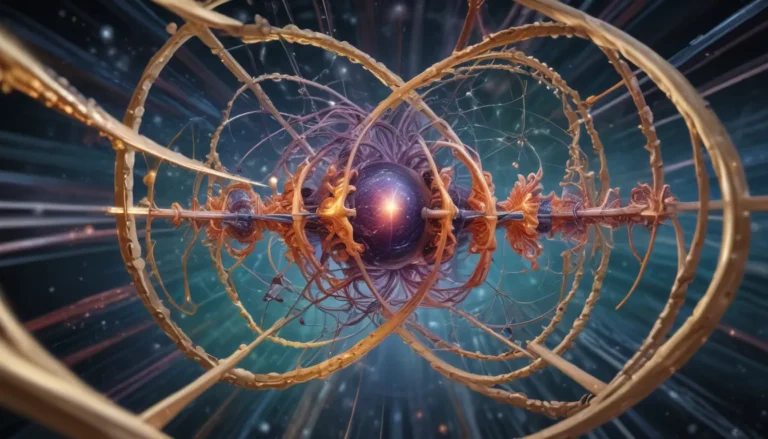A Note About Images: The images used in our articles are for illustration purposes only and may not exactly match the content. They are meant to engage readers, but the text should be relied upon for accurate information.
Have you ever wondered about the intricate dance between photons and electrons in the quantum world? The Klein-Nishina Formula holds the key to unraveling this mysterious interaction, shedding light on fundamental physics principles that shape our understanding of the universe. Developed by physicists Oskar Klein and Yoshio Nishina in the 1920s, this formula has left an indelible mark on fields such as quantum mechanics, particle physics, and astrophysics.
Exploring the Origin of the Klein-Nishina Formula
The Klein-Nishina formula, named after its visionary creators, emerged in the early 20th century as a groundbreaking tool for describing the scattering of photons by free electrons. This pivotal development marked a significant advancement in quantum electrodynamics, the branch of physics that delves into the intricate interplay between light and matter.
Unraveling the Quantum Electrodynamics Connection
At the heart of quantum electrodynamics lies the Klein-Nishina formula, a crucial component that provides a mathematical framework for understanding how photons interact with electrons in various scattering processes. This formula serves as a guiding beacon, illuminating the path towards a deeper comprehension of the quantum realm.
Decoding the Phenomenon of Compton Scattering
Among the many applications of the Klein-Nishina formula, its role in Compton scattering stands out as particularly noteworthy. This phenomenon involves the scattering of X-ray and gamma-ray photons by electrons, leading to a shift in the wavelength of the scattered radiation. Through the lens of the Klein-Nishina formula, scientists can unravel the intricacies of this intriguing process.
Embracing the Relativistic Nature of Electrons
Incorporating the relativistic nature of electrons, the Klein-Nishina formula enables researchers to study high-energy photon interactions with unparalleled precision. By considering the behavior of electrons nearing the speed of light, this formula provides invaluable insights into the dynamics of particle interactions.
Illuminating Photon Polarization Effects
Furthermore, the Klein-Nishina formula encompasses photon polarization, offering a nuanced perspective on the intricate dance between photons and electrons. By accounting for the polarization state of incident photons, scientists can deepen their understanding of scattering processes and the underlying mechanisms at play.
Unveiling the Energy Dependence of Scattering Events
The Klein-Nishina formula vividly illustrates the energy dependence of photon-electron scattering, highlighting the significant impact of incident photon energy on scattering probabilities and patterns. Higher energies give rise to distinct scattering phenomena, underscoring the intricate relationship between energy levels and scattering outcomes.
Navigating the Quantum Nature of Light
A profound reminder of the quantum nature of light, the Klein-Nishina formula underscores the dualistic behavior of photons as both particles and waves. By articulating the scattering of photons by electrons, this formula unveils the discrete, particle-like nature of light, weaving a rich tapestry of quantum truths.
Elevating Astrophysical Explorations with the Klein-Nishina Formula
Venturing into the realm of astrophysics, the Klein-Nishina formula emerges as a potent tool for unraveling high-energy phenomena such as gamma-ray bursts and active galactic nuclei. Its application in extreme cosmic environments sheds light on the intricate interactions between photons and electrons, enriching our understanding of the cosmos.
Pioneering Advances in Quantum Field Theory
As an integral component of quantum electrodynamics, the Klein-Nishina formula propels advancements in quantum field theory. By providing a robust mathematical framework for exploring fundamental particle processes, this formula lays the groundwork for groundbreaking discoveries in the realm of particles and fields.
Captivating Experimental Verifications
Experiments validating the predictions of the Klein-Nishina formula offer tangible proof of its efficacy in describing photon-electron interactions. Through meticulous measurements of energy and angle distributions of scattered photons, scientists corroborate the accuracy and reliability of this foundational formula.
Delving into Complex Multiple Particle Systems
Beyond its core applications, the Klein-Nishina formula can be extended to elucidate scattering processes involving multiple particles, such as electrons and positrons. This expansion paves the way for a deeper understanding of interactions within complex systems, enriching our insights into particle dynamics.
Harmonizing Quantum Mechanics and Special Relativity
At the intersection of quantum mechanics and special relativity lies the Klein-Nishina formula, embodying a harmonious fusion of these foundational principles. By seamlessly blending the tenets of both fields, this formula provides a comprehensive framework for delineating scattering processes involving high-energy photons and relativistic electrons.
Unveiling Cross-Sectional Dependencies in Scattering Events
The Klein-Nishina formula intricately showcases the cross-sectional dependence on various factors, including scattering angle, photon energy, and electron mass. By elucidating these dependencies, scientists glean valuable insights into the probability and intensity of scattering events, unlocking new vistas of understanding.
Unleashing the Potential of Radiation Therapy
In the realm of radiation therapy, the Klein-Nishina formula emerges as a pivotal tool for comprehending high-energy photon interactions with biological tissues. This profound knowledge underpins the precise targeting of cancer cells while minimizing harm to healthy tissues, underscoring the formula’s practical applications in medical contexts.
Driving Innovations in High-Energy Particle Accelerators
The profound insights gleaned from the Klein-Nishina formula, concerning photon-electron interactions, catalyze advancements in high-energy particle accelerators. Armed with a deep understanding of these interactions, scientists can design and optimize accelerators for diverse applications, heralding a new era of innovation in accelerator technology.
Illuminating Pathways in Particle Physics
The Klein-Nishina formula’s profound insights into scattering processes have revolutionized the field of particle physics. By unraveling the properties and interactions of fundamental particles in particle accelerators worldwide, this formula propels the frontiers of particle physics, opening new vistas of exploration.
Propelling Modern Physics Towards New Horizons
Beyond its direct applications, the Klein-Nishina formula serves as a beacon guiding modern physics towards new horizons of discovery. Its integration into quantum electrodynamics lays the groundwork for transformative breakthroughs in physics, enriching our comprehension of the fundamental nature of the universe.
Embracing the Significance of the Klein-Nishina Formula
In conclusion, the Klein-Nishina formula stands as a cornerstone in the edifice of physics, illuminating the intricacies of photon-electron interactions. Through its profound insights into quantum phenomena and scattering processes, this formula enriches our understanding of the behavior of particles and the foundational principles of quantum mechanics.
Unveiling the World of Physics
Embark on a fascinating journey into the realm of physics, exploring the captivating intricacies of phenomena such as Compton scattering and quantum electrodynamics. Delve into the enigmatic properties of gamma rays and high-energy particles, unraveling the mysteries of the universe one equation at a time. Join us on this exhilarating quest to expand your knowledge and appreciation of the awe-inspiring world of physics.
FAQs
-
What is the Klein-Nishina formula?
The Klein-Nishina formula is a foundational equation in physics that delineates the scattering of photons by free electrons, offering invaluable insights into quantum interactions and scattering phenomena. -
Who developed the Klein-Nishina formula?
Physicists Oskar Klein and Yoshio Nishina independently developed the Klein-Nishina formula in 1929, building upon the pioneering work of Arthur Compton and contributing to our understanding of photon-electron interactions. -
What is the significance of the Klein-Nishina formula?
The Klein-Nishina formula holds immense significance in various fields of physics, including nuclear physics, particle physics, and astrophysics, providing a robust mathematical framework for analyzing quantum phenomena and advancing scientific knowledge. -
How does the Klein-Nishina formula contribute to our understanding of quantum mechanics?
By elucidating the behavior of particles at the quantum level, the Klein-Nishina formula enriches our understanding of quantum mechanics, shedding light on the intricate dynamics of particle interactions and scattering processes. -
Are there practical applications of the Klein-Nishina formula?
Indeed, the Klein-Nishina formula finds practical applications in diverse fields, ranging from medical imaging techniques to particle accelerator design. Its profound insights serve as a cornerstone for advancements in nuclear physics and astrophysics, shaping cutting-edge research endeavors.
Join Us in the Exploration of Physics
As you traverse the captivating realm of the Klein-Nishina formula, immerse yourself in the awe-inspiring landscapes of physics, where every equation unveils a new facet of our universe’s intricate tapestry. Join us on this exhilarating quest to unravel the mysteries of the quantum world and embark on a journey of discovery and enlightenment.






